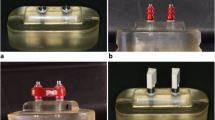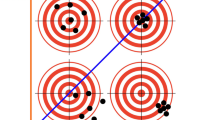Abstract
Purpose
This study describes a method for measuring the accuracy of the virtual impression.
Methods
In vitro measurements according to a metrological approach were based on (1) use of an opto-mechanical coordinate measuring machine to acquire 3D points from a master model, (2) the mathematical reconstruction of regular geometric features (planes, cylinders, points) from 3D points or an STL file, and (3) consistent definition and evaluation of position and distance errors describing scanning inaccuracies. Two expert and two inexpert operators each made five impressions. The 3D position error, with its relevant X, Y, and Z components, the mean 3D position error of each scanbody, and the intra-scanbody distance error were measured using the analysis of variance and the Sheffe’s test for multiple comparison.
Results
Statistically significant differences in the accuracy of the impression were observed among the operators for each scanbody, despite the good reliability (Cronbach’s \(\alpha \) = 0.897). The mean 3D position error of the digital impression was between 0.041 ± 0.023 mm and 0.082 ± 0.030 mm.
Conclusions
Within the limitations of this in vitro study, which was performed using a single commercial system for preparing digital impressions and one test configuration, the data showed that the digital impressions had a level of accuracy comparable to that reported in other studies, and which was acceptable for clinical and technological applications. The distance between the individual positions (#36 to #46) of the scanbody influenced the magnitude of the error. The position error generated by the intraoral scanner was dependent on the length of the arch scanned. Operator skill and experience may influence the accuracy of the impression.






Similar content being viewed by others
References
Bidez MW, Misch CE (1992) Force transfer in implant dentistry: basic concepts and principles. J Oral Implantol 18:264–274
Brosh T, Pilo R, Sudai D (1998) The influence of abutment angulation on strains and stresses along the implant/bone interface: comparison between two experimental techniques. J Prosthet Dent 79:328–334
Stanford CM, Brand RA (1999) Toward an understanding of implant occlusion and strain adaptive bone modeling and remodeling. J Prosthet Dent 81:553–561
Sahin S, Cehreli MC, Yalçin E (2002) The influence of functional forces on the biomechanics of implant-supported prostheses-a review. J Dent 30:271–282
Wang T-M, Leu L-J, Wang J, Lin L-D (2002) Effects of prosthesis materials and prosthesis splinting on peri-implant bone stress around implants in poor-quality bone: a numeric analysis. Int J Oral Maxillofac Implants 17:231–237
Kallus T, Bessing C (1994) Loose gold screws frequently occur in full-arch fixed prostheses supported by osseointegrated implants after 5 years. Int J Oral Maxillofac Implants 9:169–178
Schwarz MS (2000) Mechanical complications of dental implants. Clin Oral Implants Res 11:156–158
Brägger U, Aeschlimann S, Bürgin W, Hämmerle CH, Lang NP (2001) Biological and technical complications and failures with fixed partial dentures (FPD) on implants and teeth after four to five years of function. Clin Oral Implants Res 12:26–34
Lindström H, Preiskel H (2001) The implant-supported telescopic prosthesis: a biomechanical analysis. Int J Oral Maxillofac Implants 16:34–42
Al-Turki LEE Chai J, Lautenschlager EP, Hutten MC (2002) Changes in prosthetic screw stability because of misfit of implant-supported prostheses. Int J Prosthodont 15:38–42
Lang LA, Wang R-F, May KB (2002) The influence of abutment screw tightening on screw joint configuration. J Prosthet Dent 87:74–79
van der Meer WJ, Andriessen FS, Wismeijer D, Ren Y (2012) Application of intra-oral dental scanners in the digital workflow of implantology. PLoS ONE 7:e43312. https://doi.org/10.1371/journal.pone.0043312
Ender A, Mehl A (2011) Full arch scans: conventional versus digital impressions-an in-vitro study. Int J Comput Dent 14:11–21
Ender A, Mehl A (2013) Influence of scanning strategies on the accuracy of digital intraoral scanning systems. Int J Comput Dent 16:11–21
Patzelt SBM, Emmanouilidi A, Stampf S, Strub JR, Att W (2014) Accuracy of full-arch scans using intraoral scanners. Clin Oral Investig 18:1687–1694. https://doi.org/10.1007/s00784-013-1132-y
Güth J-F, Keul C, Stimmelmayr M, Beuer F, Edelhoff D (2013) Accuracy of digital models obtained by direct and indirect data capturing. Clin Oral Investig 17:1201–1208. https://doi.org/10.1007/s00784-012-0795-0
Flügge TV, Schlager S, Nelson K, Nahles S, Metzger MC (2013) Precision of intraoral digital dental impressions with iTero and extraoral digitization with the iTero and a model scanner. Am J Orthod Dentofacial Orthop 144:471–478. https://doi.org/10.1016/j.ajodo.2013.04.017
Gimenez-Gonzalez B, Hassan B, Özcan M, Pradíes G (2017) An in vitro study of factors influencing the performance of digital intraoral impressions operating on active wavefront sampling technology with multiple implants in the edentulous maxilla. J Prosthodont 26:650–655. https://doi.org/10.1111/jopr.12457
Henkel GL (2007) A comparison of fixed prostheses generated from conventional vs digitally scanned dental impressions. Compend Contin Educ Dent 28(8):422–424, 426–428, 430–431.
Syrek A, Reich G, Ranftl D, Klein C, Cerny B, Brodesser J (2010) Clinical evaluation of all-ceramic crowns fabricated from intraoral digital impressions based on the principle of active wavefront sampling. J Dent 38:553–559. https://doi.org/10.1016/j.jdent.2010.03.015
Brawek PK, Wolfart S, Endres L, Kirsten A, Reich S (2013) The clinical accuracy of single crowns exclusively fabricated by digital workflow-the comparison of two systems. Clin Oral Investig 17:2119–2125. https://doi.org/10.1007/s00784-013-0923-5
Güth J-F, Runkel C, Beuer F, Stimmelmayr M, Edelhoff D, Keul C (2017) Accuracy of five intraoral scanners compared to indirect digitalization. Clin Oral Investig 21:1445–1455. https://doi.org/10.1007/s00784-016-1902-4
Ortorp A, Jemt T, Bäck T, Jälevik T (2003) Comparisons of precision of fit between cast and CNC-milled titanium implant frameworks for the edentulous mandible. Int J Prosthodont 16:194–200
Al-Fadda SA, Zarb GA, Finer Y (2007) A comparison of the accuracy of fit of 2 methods for fabricating implant-prosthodontic frameworks. Int J Prosthodont 20:125–131
Torsello F, di Torresanto VM, Ercoli C, Cordaro L (2008) Evaluation of the marginal precision of one-piece complete arch titanium frameworks fabricated using five different methods for implant-supported restorations. Clin Oral Implants Res 19:772–779
Almasri R, Drago CJ, Siegel SC, Hardigan PC (2011) Volumetric misfit in CAD/CAM and cast implant frameworks: a university laboratory study. J Prosthodont 20:267–274. https://doi.org/10.1111/j.1532-849X.2011.00709.x
Barbier L, Abeloos J, De Clercq C, Jacobs R (2012) Peri-implant bone changes following tooth extraction, immediate placement and loading of implants in the edentulous maxilla. Clin Oral Investig 16:1061–1070. https://doi.org/10.1007/s00784-011-0617-9
Örtorp A, Jemt T (2012) CNC-milled titanium frameworks supported by implants in the edentulous jaw: a 10-year comparative clinical study. Clin Implant Dent Relat Res 14:88–99. https://doi.org/10.1111/j.1708-8208.2009.00232.x
Lopes A, Maló P, de Araújo Nobre M, Sanchez-Fernández E (2015) The NobelGuide\(\textregistered {R}\) All-on-4\(\textregistered {R}\) treatment concept for rehabilitation of edentulous jaws: a prospective report on medium- and long-term outcomes. Clin Implant Dent Relat Res 17:e406–416. https://doi.org/10.1111/cid.12260
Weinstein R, Agliardi E, Fabbro MD, Romeo D, Francetti L (2012) Immediate rehabilitation of the extremely atrophic mandible with fixed full-prosthesis supported by four implants. Clin Implant Dent Relat Res 14:434–441. https://doi.org/10.1111/j.1708-8208.2009.00265.x
Paniz G, Stellini E, Meneghello R, Cerardi A, Gobbato EA, Bressan E (2013) The precision of fit of cast and milled full-arch implant-supported restorations. Int J Oral Maxillofac Implants 28:687–693
Di Fiore A, Meneghello R, Savio G, Sivolella S, Katsoulis J, Stellini E (2015) In vitro implant impression accuracy using a new photopolymerizing SDR splinting material. Clin Implant Dent Relat Res 17:e721–729. https://doi.org/10.1111/cid.12321
Giménez B, Özcan M, Martínez-Rus F, Pradíes G (2014) Accuracy of a digital impression system based on parallel confocal laser technology for implants with consideration of operator experience and implant angulation and depth. Int J Oral Maxillofac Implants 29:853–862
Giménez B, Özcan M, Martínez-Rus F, Pradíes G (2015) Accuracy of a digital impression system based on active wavefront sampling technology for implants considering operator experience, implant angulation, and depth. Clin Implant Dent Relat Res 17:e54–64. https://doi.org/10.1111/cid.12124
Giménez B, Özcan M, Martínez-Rus F, Pradíes G (2015) Accuracy of a digital impression system based on active triangulation technology with blue light for implants: effect of clinically relevant parameters. Implant Dent 24:498–504. https://doi.org/10.1097/ID.0000000000000283
Kreidler SM, Muller KE, Grunwald GK, Ringham BM, Coker-Dukowitz ZT, Sakhadeo UR, Barón AE, Glueck DH (2013) GLIMMPSE: online power computation for linear models with and without a baseline covariate. J Stat Softw 54(10):i10
Landis JR, Koch GG (1977) The measurement of observer agreement for categorical data. Biometrics 33:159–174
Ender A, Mehl A (2015) In-vitro evaluation of the accuracy of conventional and digital methods of obtaining full-arch dental impressions. Quintessence Int 46:9–17. https://doi.org/10.3290/j.qi.a32244
Vandeweghe S, Vervack V, Dierens M, De Bruyn H (2017) Accuracy of digital impressions of multiple dental implants: an in vitro study. Clin Oral Implants Res 28:648–653. https://doi.org/10.1111/clr.12853
Mörmann W, Brandestini M, Ferru A, Lutz F, Krejci I (1985) Marginal adaptation of adhesive porcelain inlays in vitro. Schweiz Monatsschr Zahnmed 95:1118–1129
Denissen H, Dozić A, van der Zel J, van Waas M (2000) Marginal fit and short-term clinical performance of porcelain-veneered CICERO, CEREC, and Procera onlays. J Prosthet Dent 84:506–513. https://doi.org/10.1067/mpr.2000.110258
van der Zel JM, Vlaar S, de Ruiter WJ, Davidson C (2001) The CICERO system for CAD/CAM fabrication of full-ceramic crowns. J Prosthet Dent 85:261–267. https://doi.org/10.1067/mpr.2001.114399
Andriessen FS, Rijkens DR, van der Meer WJ, Wismeijer DW (2014) Applicability and accuracy of an intraoral scanner for scanning multiple implants in edentulous mandibles: a pilot study. J Prosthet Dent 111:186–194. https://doi.org/10.1016/j.prosdent.2013.07.010
Dehurtevent M, Robberecht L, Béhin P (2015) Influence of dentist experience with scan spray systems used in direct CAD/CAM impressions. J Prosthet Dent 113:17–21. https://doi.org/10.1016/j.prosdent.2014.07.006
Stimmelmayr M, Güth J-F, Erdelt K, Edelhoff D, Beuer F (2012) Digital evaluation of the reproducibility of implant scanbody fit-an in vitro study. Clin Oral Investig 16:851–856. https://doi.org/10.1007/s00784-011-0564-5
Author information
Authors and Affiliations
Corresponding author
Ethics declarations
Conflict of interest
The authors declare that they have no conflict of interest.
Human and animal rights
This article does not contain any studies with human participants or animals performed by any of the authors.
Informed consent
This article does not contain patient data.
Rights and permissions
About this article
Cite this article
Ciocca, L., Meneghello, R., Monaco, C. et al. In vitro assessment of the accuracy of digital impressions prepared using a single system for full-arch restorations on implants. Int J CARS 13, 1097–1108 (2018). https://doi.org/10.1007/s11548-018-1719-5
Received:
Accepted:
Published:
Issue Date:
DOI: https://doi.org/10.1007/s11548-018-1719-5




